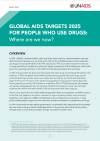Publications - Released in 2024
In 2019, UNAIDS published Health, rights and drugs: harm reduction, decriminalization and zero discrimination for people who use drugs which laid out the irrefutable evidence that people who use drugs were being left behind in the HIV response. The report demonstrated how the war on drugs was failing in its efforts to reduce the supply and demand of illicit substances, while at the same time causing untold harm to the health and well-being of people who use drugs. In 2024, five years later, the data show that people who inject drugs are still being left behind in the response. In 2022, the global median HIV prevalence among people who inject drugs was 5% across 50 reporting countries, seven times higher than among the rest of the adult population (aged 15–49 years). This figure hides significant geographical and population-based disparities. Among reporting countries, HIV prevalence ranged from 0% to 51%. Among the 16 countries with gender disaggregated data, the reported median HIV prevalence among men who inject drugs was 9%, while it was nearly double (15%) among women who inject drugs. There is some good news: the Global AIDS Strategy 2021–2026: end inequalities. end AIDS contains, for the first time, targets on law reform, reduction in stigma and discrimination, and community leadership in the response. In 2023, a United Nations Human Rights Council resolution on drug policy included explicit support for harm reduction and decriminalization for people who use drugs.
Downloads
Organizations
- Joint United Nations Programme on HIV/AIDS (UNAIDS)






